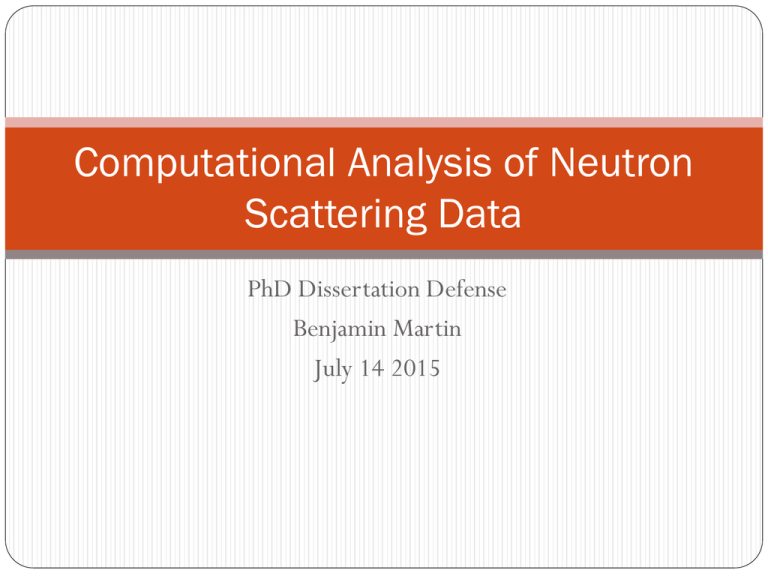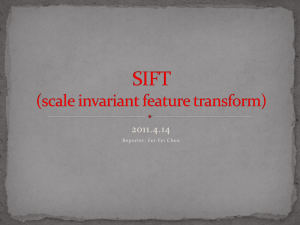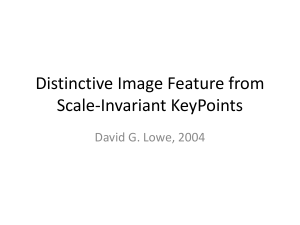Presentation
advertisement

Computational Analysis of Neutron Scattering Data PhD Dissertation Defense Benjamin Martin July 14 2015 About Me B.S. Computer Engineering 2009 M.S. Computer Engineering 2012 Intern at ORNL for 5 years Worked on satellite image processing using machine learning for most of ORNL internship Some of my more recent research has involved data processing for neutron scattering experiments Shared many similarities with my satellite imagery work Focus on crystal defect detection Joint effort between some of the computational groups at ORNL and groups at SNS Quick Recap from Proposal Crystal Structures Crystals are repeating structures of “unit cells” of atoms Atoms are the same for all cells Repeating structure is called “long-range order” A defect occurs when the periodic structure is disrupted These defects affect material strength, thermal conductivity, pharmaceutical properties, and more. Neutron Scattering Background Looking at diffuse neutron scattering Used for analysis of crystal lattice structures Neutrons pass through sample and create diffraction patterns Diffraction patterns create reciprocal space image Discrete Fourier transform for cell structure factors Neutron Scattering Background Two parts of reciprocal space images: Bragg peaks High-intensity diffraction patterns Describe average crystal structure Diffuse scattering Low-intensity diffraction patterns Describe deviations from average crystal structure Goal: Analyze textures in the reciprocal space imagery to identify defects in simulated crystal structures Single crystal neutron scattering Diffuse scattering patterns will be the primary focus as they describe deviations from the average crystal structure Neutron Scattering Background Different defects create different diffraction patterns Can be viewed as a “fingerprint” for the defect Preliminary Work from Proposal Goal: Automatically detect defects in simple simulated crystal structures for single crystal scattering experiments General Approach: Extract texture features from reciprocal space images Look at problem as a generic data classification problem Minimal knowledge of underlying crystal structure needed No need for system changes if crystal structure changes Preliminary Work from Proposal Experimental results: 2-class defect classification accuracy: 98.05% 3-class defect classification accuracy: 76.12% Lower accuracy due to similarities between substitution classes Extra proof of concept work since proposal Increasing class separation margin for substitutions had little to no effect on classification accuracy in 3-class problem System was able to also detect substitution location 64-class substitution location accuracy: 95.67% Random forests were found to perform better than SVMs Both in accuracy and computational complexity Details for this preliminary work are available in dissertation Large Structure Analysis Overview Preliminary work was a proof of concept Tested if defect detection methodology works at all Dataset was for a toy problem Crystal structure was not realistic Defects were very, very simplistic Next step: Scale up to a larger structure Defects can be more complex Larger reciprocal space image size Intensity range is much larger than small structure data range Large Structure Data Properties Data is for close-packed crystal structures Simulated using the DISCUS simulator Developed by Los Alamos National Laboratory Uses similar methodology to (Butler and Welberry, 1992) Adds extra variables to make simulation more realistic Crystal structure is a 100 cell by 100 cell silicon lattice Image size is 501 pixels by 501 pixels Single-band intensity maps Comparison to preliminary data: Lattice was 8 cells by 8 cells Image size was 129 pixels by 129 pixels Close-Packed Crystal Structures Close-packed crystal structures are created by stacking layers of atoms to form a crystal lattice Layers denoted as letters (A, B, C, etc.) Stacks are represented by strings (ABC) Two stacking configurations: Cubic close packed (CCP) 3-layer configuration Hexagonal close packed (HCP) 2-layer configuration Close-Packed Structure Defects Two types of defects considered Stacking faults Switching from cubic to hexagonal structure (or vice-versa) Short-range order (SRO) Small areas of disorder within the crystal Close-Packed Structure Defects Defects can be similar in appearance No Defect SRO Close-Packed Structure Defects Defects can be similar in appearance Stacking Fault SRO Image Feature Extraction Keypoint features Automatically detect keypoints (regions of interest) within the image and generate a descriptor for each keypoint location Descriptor is feature vector describing the texture of the image at the keypoint location Image Keypoint Extractors 3 keypoint extraction algorithms evaluated: SIFT 128-dimensional feature vectors Advertised benefits: “Gold standard” for keypoint features SURF Similar to SIFT, slightly different features (approximations) 64-dimensional feature vectors Advertised benefits : Faster than SIFT ORB Open-source alternative to SIFT and SURF 256-dimensional binary feature vectors Advertised benefits : Real-time performance, high noise robustness Defect Detection Methodology Two challenges were posed by the new data: Large image intensity range Increased volume of detected keypoints due to larger image size In order to accommodate for the large range, a preprocessing step was added that scales the data before keypoint extraction Improved keypoint detection for diffuse textures The increased number of detected keypoints was addressed by training on only 10% of the keypoints for each image Reduced time required to train classifier without significantly affecting accuracy Defect Detection Methodology Two challenges were posed by the new data: Large image intensity range Increased volume of detected keypoints due to larger image size In order to accommodate for the large range, a preprocessing step was added that scales the data before keypoint extraction Improved keypoint detection for diffuse textures The increased number of detected keypoints was addressed by training on only 10% of the keypoints for each image Reduced time required to train classifier without significantly affecting accuracy Image Preprocessing Large structure data intensity range is huge Typically in the ballpark of [0, 106] Range for preliminary data was approximately [0, 650] Problem: Causes problems during keypoint extraction Makes keypoint detection difficult Scaling is needed as a preprocessing step Common practice seems to be thresholding intensities at 10%–15% of the maximum intensity value Percentage seems to be “eyeballed” Still not good enough for keypoint extraction Image Preprocessing The large data range was due to the Bragg peaks Goal: Reduce Bragg peak intensity without affecting diffuse scattering patterns GUI developed to assist with scaling scheme for Bragg peaks Result: Scaling methodology developed that thresholds the intensity I(p) at pixel p in the image such that: 𝐼𝑛𝑒𝑤 𝑝 = min 𝐼 𝑝 , 𝑡 where threshold t is the mean intensity for the image Image Preprocessing GUI Screenshot (Intensity Mode) Image Preprocessing GUI Screenshot (Keypoint Mode) Image Preprocessing Fixed Percentage Scaling (1% max) Image Preprocessing Mean Scaling Large Structure Experiment Goal: Classify image as belonging to 1 of 3 defect classes: “No Defect”, “Stacking Fault”, “SRO” Classes suggested by neutron scientists as hard to distinguish visually 600 images simulated via DISCUS 200 No Defect (100 CCP/100 HCP) 200 Stacking Fault (100 CCP/100 HCP) 200 SRO (100 CCP/100 HCP) Note: No distinction was made between CCP and HCP samples during training Learning to ignore stacking configuration and just focus on the defects was left to the learning algorithm Large Structure Experiment Preprocessing: Images scaled via mean scaling method Linear scaling to [0,255] then performed as required by keypoint extractors 3 keypoint extractors tested: SIFT, SURF, and ORB Training: Random forest classifier Used 10% of the images in the dataset Random 10% of the keypoints in each image used for training Keypoint voting used to classify test images Results averaged over 100 independent experiments Large Structure Experiment Results: Keypoint Extractor Accuracy SIFT 96.36% SURF 93.04% ORB 92.59% Conclusions: This “difficult” defect detection problem was rather easy to solve using the computational defect detection methodology SIFT had highest accuracy of the keypoint extractors More on keypoint extractor evaluation in a moment… Prediction Evaluation Criteria Question: How to evaluate the quality of a prediction? What happens if there is a voting tie or general uncertainty? Goal is to reduce need for human evaluation Cannot expect classifier to be perfect A heuristic may be misleading Solution: Assign confidence measure to each prediction Defined as the percentage of keypoints that belong to the class that “won” the vote Samples with confidence falling below a predefined threshold can be flagged for human evaluation Prediction Evaluation Criteria Mean confidence for experiment Keypoint Extractor Mean Confidence SIFT 75.98% SURF 81.61% ORB 79.39% Word of Caution: A high mean confidence does not imply high accuracy Primary goal is to maximize accuracy Only then can confidence be maximized Keypoint Extractor Evaluation The keypoint extractors were evaluated using two criteria: Classification accuracy Computational complexity with respect to image size Classification accuracy SIFT had higher accuracy than SURF or ORB Computational complexity All three extractors have complexity O(mn) for an image of dimensions m pixels by n pixels Detailed ORB analysis is available in dissertation appendix However, there is more to consider… Keypoint Extractor Evaluation Benchmark graph for keypoint extractors: Keypoint Extractor Evaluation Computational complexity observations: Computational complexities are the same, but the running times are very different Times required to process a single image vary by algorithm Longer feature vectors cause subsequent processing steps to require more time to complete Summary: SIFT has higher accuracy at the cost of longer running times ORB runs faster than SIFT at the cost of lower accuracy A researcher will need to consider the tradeoff between higher accuracy and shorter completion time Conclusion Conclusion Crystal defects can be detected using image processing and machine learning methods Detection methodology presented and verified using a series of increasingly difficult problems Scaling methodology developed to handle large intensity ranges Method to handle larger image sizes also evaluated Random forests most effective in detecting defects SIFT and ORB were the top performing keypoint extractors Confidence measure can be used to address uncertainty Future Work Real data analysis What modifications will need to be made when using real data? Experimentation with multiple defects Is it possible to detect two different defect types in an image? Defect texture analysis What textures are unique to a specific type of defect? Could help with classifying subtle differences Sensitivity quantification How subtle must defects be before they cannot be detected? First step: Determine which types of defects are hardest to detect Does sensitivity change across periodic table? Future publication expected through ORNL/SNS Summary of Contributions Evaluation of data processing methodologies for scattering data Analysis of reciprocal space imagery characteristics Development of scaling methodology for scattering data Creation of GUI to aid in reciprocal space analysis Formalization of defect detection methodology evaluated using following test cases Classification of simple defect types in small structures Prediction of defect properties in small structures Detection of more complex faults in larger structures Comparison of keypoint extractor and machine learner performance in the context of reciprocal space imagery Including detailed complexity analysis for ORB keypoint extractor Goals from Proposal All goals from proposal completed Small structures: Analysis of substitution class separation Small structures: Detection of substitution location Large structures: Analysis of data properties Development of scaling methodology Defect detection for large crystal structures Evaluation of feature extractors and machine learning methods Including computational complexity analysis Detailed analysis for ORB Study of tie-breaking and confidence for defect predictions Thank You Questions? Extra Slides Current Detection Methodology State-of-the-art crystal defect detection: Current Detection Methodology State-of-the-art crystal defect detection: SPOT THE DIFFERENCE Current Detection Methodology State-of-the-art crystal defect detection: SPOT THE DIFFERENCE (HINT: HERE’S A DIFF) Sample Reciprocal Space Image Reciprocal Space Definition Total complex scattered amplitude: 𝐴 𝒌 = 𝑁 𝑚=1 𝐹𝑚 exp 𝑖𝒌 ∙ 𝑹𝑚 where: N = number of cells in the lattice 𝐹𝑚 = structure factor for mth cell (listed below) k = diffraction wave vector 𝑹𝑚 = position vector of mth cell Structure factor: 𝑁 𝑚 𝐹𝑚 = 𝑛=1 𝑓𝑛 exp(𝑖𝒌 ∙ 𝒓𝑛 ) where: 𝑓𝑛 = scattering factor for atom n 𝒓𝑛 = location of atom n within the cell Reciprocal space intensity at k : 𝐼 𝒌 = 𝐴 𝒌 𝐴∗ (𝒌) Reciprocal space images are basically the DFT magnitude for the structure Phase problem: Phase data lost = Unable to do inverse transform Feature Extraction Example Data Information Toy dataset 8 cell by 8 cell crystal lattice 129 pixel by 129 pixel intensity maps Cells contain two atoms with different scattering factors Crystal is for proof of concept Not intended to represent a realistic crystal Reciprocal space images: Single band pixel intensity maps Simulated dataset Generated with the help of ORNL staff using methodology presented in (Butler and Welberry, 1992) Simulations are apparently very accurate and seem to be a common step before performing neutron scattering experiment Feature Classification Any classifier can be used at this point Three types of classifiers were evaluated in the experiments: Support vector machine (Linear kernel) Support vector machine (RBF kernel) Random forest Input data points: Keypoint descriptors Corresponding label for the image they were extracted from Classification of a new image involves: Collecting predictions for all of the keypoints in the image Assigning a final label via a majority vote of the keypoints Support Vector Machines SVMs seek to create a decision boundary that maximizes the margin between two classes They are a standard baseline method A kernel functions can be used to aid in separation Linear and radial basis function (RBF) evaluated Random Forests Random forests are ensembles of decision trees Each tree uses a different subset of the data Each tree node uses a subset of features to make decision Final classification is via vote or average of tree classifications Comparison of Learning Algorithms Learning algorithms evaluated using two criteria: Classification accuracy Computational complexity with respect to training sample volume Classification accuracy Random forests had consistently higher classification accuracy Computational complexity for N training samples SVM training: O(N2) – O(N3) Random forest training: O(N*log(N)) Conclusion: Random forest is the better choice It had higher accuracy in the experiments It has lower computational complexity for training Experiment: 2-class Problem Goal: Classify a crystal containing one of two defect types: Substitution (small and large) Small - scattering factor on [0,1] Large - scattering factor on (1,2) Shear Simple problem to evaluate the effectiveness of the proposed defect detection methodology No Defect Substitution Shear Experiment: 2-class Problem 600 images 400 substitution (200 large, 200 small) 200 shear SIFT descriptors extracted from each image Extractor requires images to be scaled to range [0,255] Training procedure: 3 learners tested: SVM (linear), SVM (RBF), and random forest Learner trained using keypoint descriptors Trained on 10% of images Image label is assigned to each keypoint Class of test image determined via majority vote of its keypoints Results averaged over 20 independent experiments Experiment: 2-class Problem Results: Learning Algorithm Accuracy SVM (linear) 97.31% SVM (RBF) 95.92% Random Forest 98.05% Conclusion: Methodology does good job of detecting defects All classifiers performed very well in this experiment Next step: Test using a more difficult problem Experiment: 3-class Problem Goal: Present harder problem to classifier to test the sensitivity of the defect detection methodology Split substitution class into “large substitution” and “small substitution” subsets Harder to distinguish between these classes 600 images 200 large substitution 200 small substitution 200 shear Training and classification procedure was the same as the previous 2-class experiment Experiment: 3-class Problem Results: Learning Algorithm Accuracy SVM (linear) 70.87% SVM (RBF) 70.56% Random Forest 76.12% Conclusions: Methodology is precise enough to predict subtle defect differences Random forest performed much better than the SVMs Lower overall accuracy was due to confusion between large and small substitution classes Increasing class separation did not significantly affect results Experiment: Substitution Location Goal: Evaluate whether classification methodology can be used to detect other specific properties of a defect Can location of substitution be predicted? 1000 large substitution images Substitution can be in 1 of 64 possible cell locations Feature extraction and machine learning set-up was the same as the other defect classification experiments Classification label is the integer index [0,63] for the cell containing the substitution defect Experiment: Substitution Location Results: Learning Algorithm Accuracy SVM (linear) 94.80% SVM (RBF) 73.76% Random Forest 95.67% Conclusions: It is possible to predict specific defect properties Random forest and linear SVM performed very well SVM with RBF kernel did not perform as well



